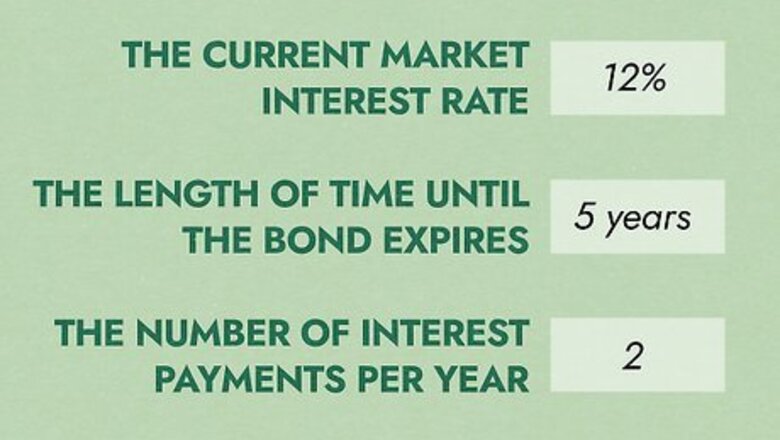
views
X
Research source
. In order to calculate how the amount of the bond discount, you need to need to calculate the present value of the principal and the present value of the coupon payments.
Calculating the Present Value of the Bond's Principal
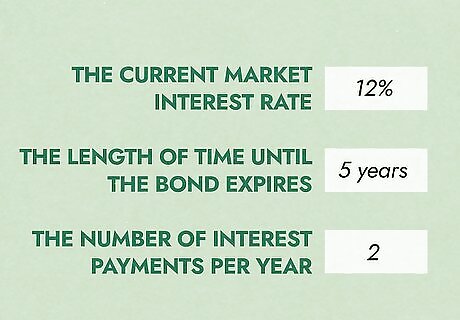
Gather the information. The present value of the bond's principal tells you its current worth based on the current market interest rate. For this calculation, you need to know the current market interest rate. Also, you need to know the length of time until the bond expires and the number of interest payments per year. For example, suppose ABC Company issues 5-year, $500,000, 10% bonds. Interest is paid semi-annually. The current market interest rate is 12 percent. In this example, the current market interest rate is 12 percent. The length of time until the bond expires is 5 years.

Calculate the current market interest rate for each payment period. Divide the annual current market interest rate by the number of interest payments per year. Using the example above, the annual market interest rate is 12 percent. Interest payments are paid semi-annually, or twice per year. The market rate per period is 6 percent ( .12 / 2 = .06 ) {\displaystyle (.12/2=.06)} (.12/2=.06).
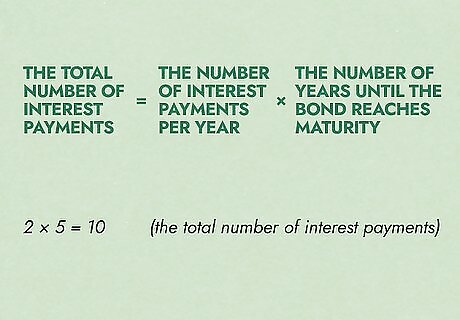
Calculate the total number of interest payments. Multiply the number of interest payments per year by the number of years until the bond reaches maturity. This tells you how many interest payments will be made over the life of the bond. In the above example, interest is paid out semi-annually, or twice per year. The number of years until maturity is five. The total number of interest payments is 5 ∗ 2 = 10 {\displaystyle 5*2=10} 5*2=10.
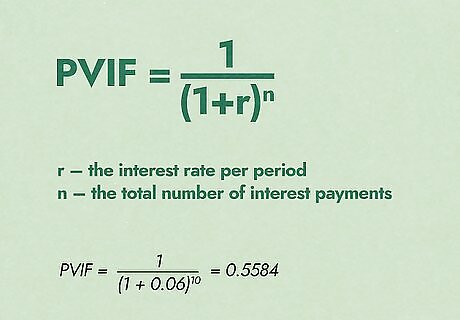
Calculate the Present Value Interest Factor (PVIF). This is used to calculate the present value of the bond based on the current market interest rate. The formula for PVIF is 1 / ( 1 + r ) n {\displaystyle 1/(1+r)^{n}} 1/(1+r)^{n}. In this formula, “r” is the interest rate per period. Also, “n” is the total number of interest payments. PVIF = 1 / ( 1 + .06 ) 10 = 0.5584 {\displaystyle 1/(1+.06)^{10}=0.5584} 1/(1+.06)^{{10}}=0.5584 Present value of the principal = principal * PVIF $ 500 , 000 ∗ 0.5584 = $ 279 , 200 {\displaystyle \$500,000*0.5584=\$279,200} \$500,000*0.5584=\$279,200
Calculating the Present Value of the Interest Payments
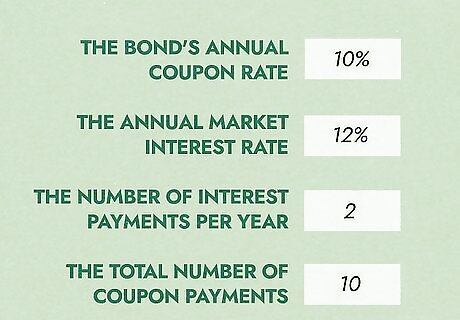
Gather the information. The present value of the interest payments tells you the current worth of the bond's interest payments based on the current market interest rate. For this calculation, you need to know the bond's annual coupon rate and the annual market interest rate. Also, find out the number of interest payments per year and the total number of coupon payments. Using the example above, the annual coupon rate is 10 percent and the annual current market interest rate is 12 percent. The number of interest payments per year is two, and there are 10 total interest payments over the life of the bond.
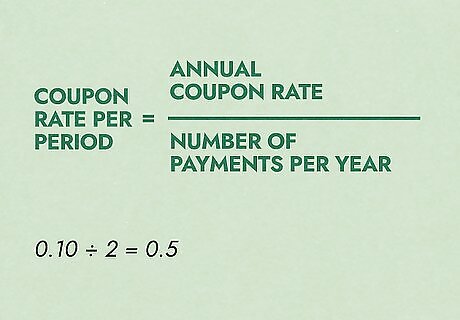
Calculate the coupon rate per period. Divide the annual coupon rate by the number of payments per year. In the above example, the annual coupon rate is 10 percent. The number of interest payments per year is two. The interest rate for each payment is 5 percent ( .10 / 2 = .5 ) {\displaystyle (.10/2=.5)} (.10/2=.5).

Calculate the amount of each interest payment. Multiply the principal of the bond by the interest rate per period. In the example above, the principal of the bond is $500,000. The interest rate per period is 5 percent. Each interest payment is $25,000 ( $ 500 , 000 ∗ .05 = $ 25 , 000 ) {\displaystyle (\$500,000*.05=\$25,000)} (\$500,000*.05=\$25,000).
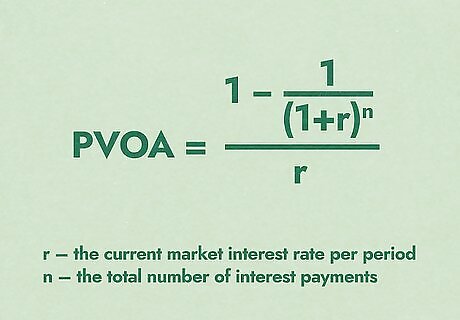
Calculate the Present Value of an Ordinary Annuity (PVOA) factor. This is used to calculate the value of the interest payments if they were to be paid now. It is based on the current market interest rate. The formula is [ ( 1 − ( 1 / ( 1 + r ) n ) ) / r ] {\displaystyle [(1-(1/(1+r)^{n}))/r]} [(1-(1/(1+r)^{n}))/r]. In this formula, “r” is the current market interest rate per period and “n” is the total number of interest payments. [ ( 1 − ( 1 / ( 1 + .06 ) 10 ) ) / .06 ] = 7.3601 {\displaystyle [(1-(1/(1+.06)^{10}))/.06]=7.3601} [(1-(1/(1+.06)^{{10}}))/.06]=7.3601
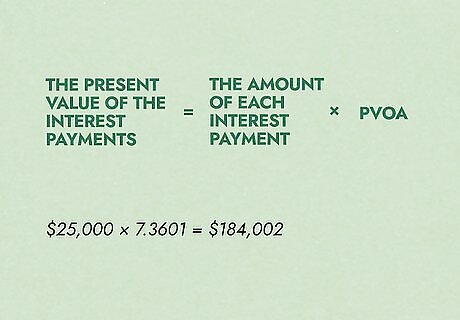
Calculate the present value of the interest payments. Multiply the amount of each interest payment by the PVOA. This tells you how much the interest payments would be worth if they were all paid out today. Use the equation $ 25 , 000 ∗ 7.3601 = $ 184 , 002 {\displaystyle \$25,000*7.3601=\$184,002} \$25,000*7.3601=\$184,002. The present value of the interest payments is $184,002.
Calculating the Bond Discount Rate
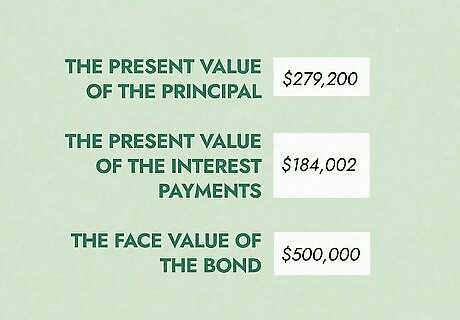
Gather the information. You need the results of your two prior calculations. First you need to know the present value of the principal of the bond. Also, you need to know the present value of the interest payments. Finally, you need to know the face value of the bond. Using the above example, the present value of the principal is $279,200. The present value of the interest payments is $184,002. The bond's face value is $500,000.
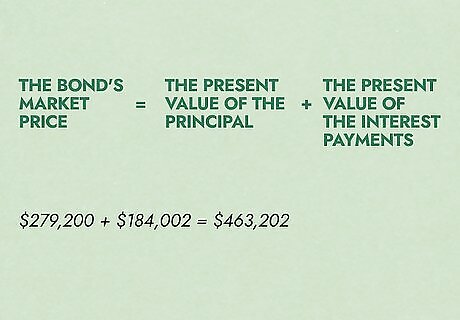
Calculate the bond's market price. This tells you the price for which you should offer the bond. It is based on the current market interest rate. It is the sum of the present value of the principal plus the present value of the interest payments. Using the above example, the bond's market price is $ 279 , 200 + $ 184 , 002 = $ 463 , 202 {\displaystyle \$279,200+\$184,002=\$463,202} \$279,200+\$184,002=\$463,202.
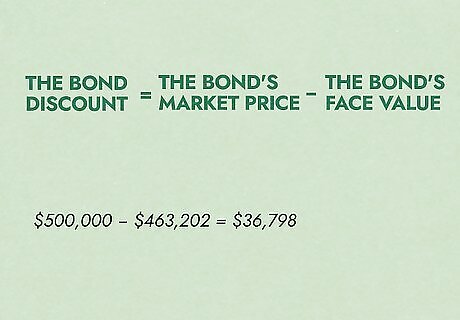
Calculate the bond discount. Compare the bond's market price which you just calculated with the bond's face value. In the example above, the bond's market price is lower than the face value. Therefore, the bond will be offered at a discount. $ 500 , 000 − $ 462 , 202 = $ 36 , 798 {\displaystyle \$500,000-\$462,202=\$36,798} \$500,000-\$462,202=\$36,798. The bond discount is $36,798.

Calculate the bond discount rate. This tells your the percentage, or rate, at which you are discounting the bond. Divide the amount of the discount by the face value of the bond. Using the above example, divide $36,798 by $500,000. $ 36 , 798 / $ 500 , 000 = .073596 {\displaystyle \$36,798/\$500,000=.073596} \$36,798/\$500,000=.073596 The discount rate for the bond is 7.36 percent.

Compare the calculated discounted bond value with the market price. If the market price is lower than the calculated discounted bond value, then you can consider the bond a good buy. If the market price is higher than the calculated bond, then you might want to hold off.


















Comments
0 comment